Kinga of Poland
| Saint Kinga of Poland | |
|---|---|
.jpg) | |
| Born |
5 March 1224 Esztergom, Kingdom of Hungary |
| Died |
24 July 1292 (aged 68) Stary Sącz, Kingdom of Poland |
| Venerated in | Catholic Church |
| Beatified | 11 June 1690 by Pope Alexander VIII |
| Canonized | 16 June 1999 by Pope John Paul II |
| Feast | 24 July |
| Attributes | depicted as an abbess; crown |
| Patronage | Poland, Lithuania |
Saint Kinga of Poland (also known as Cunegunda; Polish: Święta Kinga, Hungarian: Szent Kinga) (5 March 1224 – 24 July 1292) is a saint in the Catholic Church and patroness of Poland and Lithuania.[1][2]
Biography
She was born in Esztergom, Kingdom of Hungary, the daughter of King Béla IV of Hungary and Maria Laskarina. She was a niece of Elizabeth of Hungary and great-niece of Saint Hedwig. Kinga's sisters were Saint Margaret of Hungary and blessed Jolenta of Poland. She reluctantly married Bolesław V ("the Chaste") and became princess when her husband ascended the throne as High Duke of Poland.[3] Despite the marriage, the devout couple took up a vow of chastity. The marriage was largely arranged by and the vow of chastity patterned after that of Bolesław's sister, blessed Salomea of Poland.[4]
During her reign Kinga got involved in charitable works such as visiting the poor and helping the lepers. When her husband died in 1279, she sold all her material possessions and gave the money to the poor. She soon did not want any part in governing the kingdom which was left to her and decided to join the Poor Clares monastery at Sandec (Stary Sącz). She would spend the rest of her life in contemplative prayer and did not allow anyone to refer to her past role as Grand Duchess of Poland. She died on 24 July 1292, aged 68.
Veneration
Pope Alexander VIII beatified Kinga in 1690. In 1695, she was made chief patroness of Poland and Lithuania. On 16 June 1999, she was canonized by Pope John Paul II.[5]
Legend
Legend has it that Kinga threw her engagement ring into the Maramures salt mine in Hungary. The ring miraculously traveled along with salt deposits to Wieliczka where it was rediscovered. On the spot the miners erected a statue of Saint Kinga, carved entirely from salt which is 101 meters under the Earth's surface.[6]
- Saint Kinga
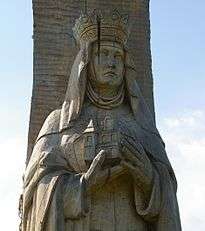 The wooden sculpture of Saint Kinga of Poland in Wiślica.
The wooden sculpture of Saint Kinga of Poland in Wiślica. Statue of St. Kinga (1820) in Nowy Korczyn
Statue of St. Kinga (1820) in Nowy Korczyn.jpg) St. Joseph's Church, Muszyna, Poland
St. Joseph's Church, Muszyna, Poland Saint Kinga's Chapel, Wieliczka Salt Mine
Saint Kinga's Chapel, Wieliczka Salt Mine.jpg) Statue of Saint Kinga, carved in salt in the cathedral of Saint Kinga of Poland
Statue of Saint Kinga, carved in salt in the cathedral of Saint Kinga of Poland Saint Kingas Chapel depicting when a miner finds her ring.
Saint Kingas Chapel depicting when a miner finds her ring.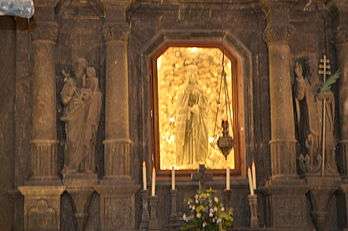 Saint Kinga of Poland's altar in Wieliczka
Saint Kinga of Poland's altar in Wieliczka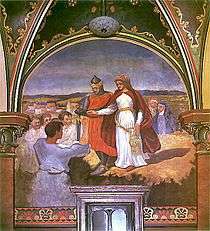 St. Kinga, depicted by Włodzimierz Tetmajer
St. Kinga, depicted by Włodzimierz Tetmajer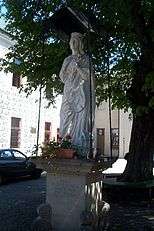 Monument to St. Kinga at the monastery of Stary Sącz
Monument to St. Kinga at the monastery of Stary Sącz Statue of Saint Kinga, near Trzy Korony
Statue of Saint Kinga, near Trzy Korony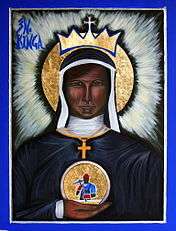 St Kinga icon, near Rochester, New York
St Kinga icon, near Rochester, New York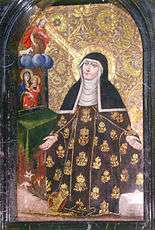 Saint Kinga of Poland
Saint Kinga of Poland
Ancestry
| Ancestors of Kinga of Poland | ||||||||||||||||||||||||||||||||||||||||||||||||||||||||||||||||||||||||||||||||||||||||||||||||||||||||||||||||||||||||||||||||||||||||||||||||||||||||||||||||||||||||||||||||||||||||||||||||||||||||||||||||||||||||||||||||||||||||||||||||||||||||||||||||||||||||||||||||||||||||||||||||||||||||||||||||||||||||||||||||||||||||||||||||||||||||||||||||||||||||||||||||||||||||||||||||||||||||||||||||||||||||||||||||||||||||||||||||||||||||||||||||||||||||||||||||||||||||||||||||||||||||||||||||||||||||||||||||||
|---|---|---|---|---|---|---|---|---|---|---|---|---|---|---|---|---|---|---|---|---|---|---|---|---|---|---|---|---|---|---|---|---|---|---|---|---|---|---|---|---|---|---|---|---|---|---|---|---|---|---|---|---|---|---|---|---|---|---|---|---|---|---|---|---|---|---|---|---|---|---|---|---|---|---|---|---|---|---|---|---|---|---|---|---|---|---|---|---|---|---|---|---|---|---|---|---|---|---|---|---|---|---|---|---|---|---|---|---|---|---|---|---|---|---|---|---|---|---|---|---|---|---|---|---|---|---|---|---|---|---|---|---|---|---|---|---|---|---|---|---|---|---|---|---|---|---|---|---|---|---|---|---|---|---|---|---|---|---|---|---|---|---|---|---|---|---|---|---|---|---|---|---|---|---|---|---|---|---|---|---|---|---|---|---|---|---|---|---|---|---|---|---|---|---|---|---|---|---|---|---|---|---|---|---|---|---|---|---|---|---|---|---|---|---|---|---|---|---|---|---|---|---|---|---|---|---|---|---|---|---|---|---|---|---|---|---|---|---|---|---|---|---|---|---|---|---|---|---|---|---|---|---|---|---|---|---|---|---|---|---|---|---|---|---|---|---|---|---|---|---|---|---|---|---|---|---|---|---|---|---|---|---|---|---|---|---|---|---|---|---|---|---|---|---|---|---|---|---|---|---|---|---|---|---|---|---|---|---|---|---|---|---|---|---|---|---|---|---|---|---|---|---|---|---|---|---|---|---|---|---|---|---|---|---|---|---|---|---|---|---|---|---|---|---|---|---|---|---|---|---|---|---|---|---|---|---|---|---|---|---|---|---|---|---|---|---|---|---|---|---|---|---|---|---|---|---|---|---|---|---|---|---|---|---|---|---|---|---|---|---|---|---|---|---|---|---|---|---|---|---|---|---|---|---|---|---|---|---|---|---|---|---|---|---|---|---|---|---|---|---|---|---|---|---|---|---|---|---|---|---|---|---|---|---|---|---|---|---|---|---|---|---|---|---|---|---|---|---|---|---|---|---|---|---|---|---|---|---|---|---|---|---|---|---|---|---|---|---|---|---|---|---|---|---|---|---|---|---|---|---|---|---|---|---|---|---|---|---|---|---|---|---|---|---|---|---|---|---|---|---|---|---|---|---|---|---|---|---|---|---|---|---|---|---|
| ||||||||||||||||||||||||||||||||||||||||||||||||||||||||||||||||||||||||||||||||||||||||||||||||||||||||||||||||||||||||||||||||||||||||||||||||||||||||||||||||||||||||||||||||||||||||||||||||||||||||||||||||||||||||||||||||||||||||||||||||||||||||||||||||||||||||||||||||||||||||||||||||||||||||||||||||||||||||||||||||||||||||||||||||||||||||||||||||||||||||||||||||||||||||||||||||||||||||||||||||||||||||||||||||||||||||||||||||||||||||||||||||||||||||||||||||||||||||||||||||||||||||||||||||||||||||||||||||||
Sources
- ↑ "Katolikus.hu St Kinga". www.katolikus.hu. Retrieved 2015. Check date values in:
|access-date=(help) - ↑ "St Kinga". Catholic Encyclopedia. 1915. Retrieved 13 February 2015.
- ↑ Sokol, Stanley S. (1992). "Cunegunda (Helen)". The Polish Biographical Dictionary: Profiles of Nearly 900 Poles who Have Made Lasting Contributions to World Civilization. Bolchazy-Carducci. p. 74. ISBN 9780865162457.
- ↑ Klaniczay, Gábor (2002-03-14). Holy Rulers and Blessed Princesses: Dynastic Cults in Medieval Central Europe. Cambridge UP. pp. 242–43. ISBN 9780521420181.
- ↑ Berglund, Bruce R.; Porter, Brian A. (2010). Christianity and Modernity in Eastern Europe. Central European UP. pp. 368 n.61. ISBN 9789639776654.
- ↑ "wielizka-mine-an-underground-cathedral-". /www.googobits.com. Retrieved November 2014. Check date values in:
|access-date=(help)
| Wikimedia Commons has media related to Kinga of Poland. |
External links
| Kinga of Poland Born: 5 March 1224 Died: 24 July 1292 | ||
| Royal titles | ||
|---|---|---|
| Preceded by Agafia of Rus |
High Duchess consort of Poland 1243–1279 |
Succeeded by Agrippina of Kiev |